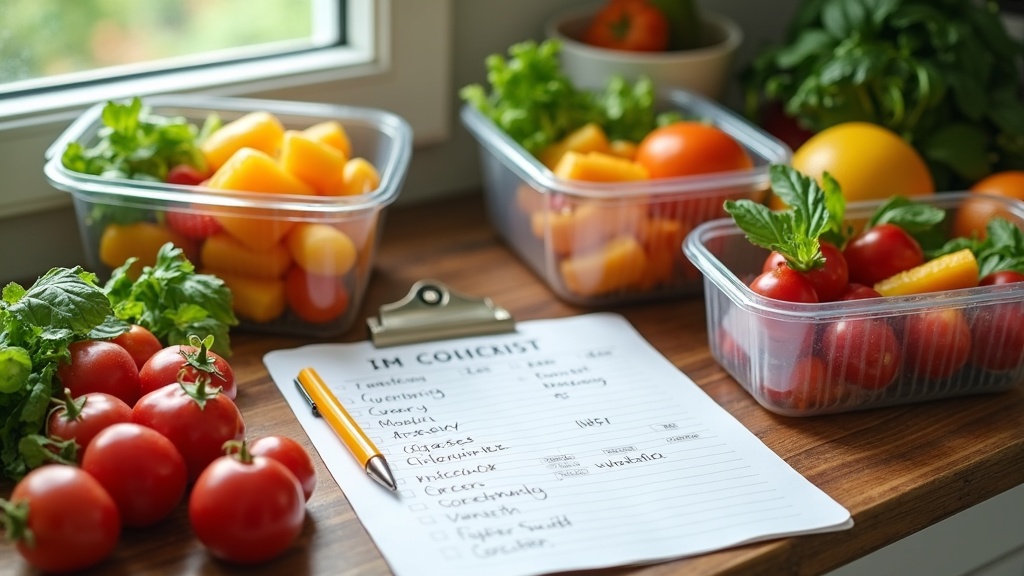Building a weekly plantbased meal planning and prep routine comes in handy for staying organized, saving time, and making healthy eating way more doable.
I get a lot of questions about how to pull together plantbased meals without constantly feeling rushed or stressed about what to cook next.
With some practical steps and a reliable checklist, sticking to your plantbased goals turns into a smoother ride.
Here’s how I manage my weekly plantbased meal planning and prep, along with tips that have really helped me (and could do the same for you).

Why Plan Weekly PlantBased Meals?
Getting set with a weekly meal plan means way less guesswork when it’s time to cook and fewer lastminute trips to the grocery store.
It’s also a simple way to make sure your meals stay well balanced and flavorful.
I find that planning plantbased meals ahead of time makes me a lot less likely to cave to random cravings or skip nutritious options altogether.
There’s a bunch of benefits beyond just feeling organized. Weekly planning helps you:
- Stick to budgetfriendly shopping lists and cut down on food waste.
- Find more variety in your daily meals instead of always eating the same thing.
- Meet nutrition goals by covering all your protein, fiber, and micronutrient needs.
- Use seasonal produce while it’s fresh and more affordable.
If this sounds pretty good, you’ll probably appreciate having a weekly checklist to keep things on track and stress free.
Foundations of a PlantBased Meal Planning Checklist
Kicking off your weekly plantbased meal prep starts with looking at the basics.
I usually ask myself a few questions before I start planning:
- How many meals do I need to cover this week (breakfast, lunch, dinner, snacks)?
- What time do I actually have for prepping meals on busy versus slow days?
- Do I want to try anything new, like a new recipe or a different vegetable?
- Are there leftovers from last week that could be used up today?
Jotting down these points gives you a clear sense of what your week will look like and makes meal sketching a lot more straightforward.
I usually recommend starting simple with a handful of easytoprep meals and then adding more complicated or creative dishes if you’re feeling up to it.
There’s no need to overcomplicate things, especially if you’re new to plantbased planning.
Quick Guide: Building Your Weekly PlantBased Meal Prep Checklist
Having a checklist for your weekly routine keeps things manageable and helps you stay focused.
Here are the steps I follow when planning and prepping my plantbased meals for the week:
- Pick Your Recipes: Choose 4–6 plantbased recipes you want to eat that week. Include a mix of mains, sides, and snacks. I usually grab favorites like veggie curries, chili, grain bowls, overnight oats, and hummus with cut veggies.
- Check Your Pantry & Fridge: Do a quick inventory before shopping. This stops double buying and helps use up older ingredients first.
- Draft a Grocery List: Write down everything you need for your chosen recipes, listing fresh produce, grains, proteins (like beans, tofu, or lentils), spices, and sauces.
- Batch Prep Staples: Cook up big portions of grains, beans, or lentils ahead of time. Washing and chopping veggies in advance (like peppers, broccoli, or carrots) shaves off a ton of weeknight prep time.
- Plan Easy Snack Options: Chop fruit, preportion nuts, make a simple plantbased dip, or bake some chickpeas for quick bites during busy days.
- Store Meals Properly: Divide meals into containers, label them, and stack them in the fridge or freezer. This is super useful when you’re late or tired after work.
- Leave Room for Flex Meals: Sometimes I want to order takeout or throw together a salad with random leftovers. Flex meals make your plan feel less rigid.
- Review and Note What Worked: I like to keep track of which recipes or prep tricks actually made my week run smoother. This makes future planning even easier and tastier.
These checklist steps make up my goto method for staying on top of plantbased meal routines.
And you don’t have to get it perfect; small improvements week to week count for a lot.
Common Challenges with PlantBased Weekly Meal Prep (And How I Manage Them)
No matter how solid the plan, things pop up.
Busy workdays, lastminute plans, or just plain forgetting something at the store can always throw things off.
Here’s how I handle common meal prep hurdles:
- Running Out of Ideas: I bookmark favorite food blogs, use Pinterest boards, and keep a photo album of recipes on my phone for inspo. Rotating different cuisines (like Mexican, Indian, or Mediterranean) gives me fresh ideas fast.
- Storage Issues: Using a mix of glass jars, stackable containers, and reusable freezer bags helps fit more into my fridge and freezer. I also try to portion servings ahead of time so reheating is quick and easy.
- Balancing Nutrition: I check that each meal includes plenty of protein, fiber, and at least 2–3 different vegetables. Meal planning tools like Cronometer or MyFitnessPal can help doublecheck nutrition for those looking to stay on top of their macros.
- Time Crunch: I block out an hour or two on Sunday for main meal prep, then about 20 minutes midweek to top up fresh veggies or whip up a quick sauce. Having a set “prep time” makes a huge difference.
- Ingredient Gaps: I always keep backup items like canned beans, frozen veg, and quickcook grains on hand to cover lastminute meals if produce runs low.
Most of these issues get easier with a little practice, and being flexible with your plan is really important for making plantbased eating sustainable.
Cool Features to Look For in a PlantBased Meal Prep Routine
Picking the right meal prep routine and tools honestly makes a huge difference in how easy the week flows.
Here are practical tips that make my plantbased prep feel less like a chore:
- Theme Nights: Having “Taco Tuesday” or “StirFry Saturday” is a fun way to keep things interesting and takes the stress out of daily decision making.
- OnePan or Sheet Pan Dinners: Roasting up a bunch of veggies and plantbased protein on one sheet pan basically cleans itself and saves so much time.
- NoCook Options: Overnight oats, vibrant salads, and wraps are lifesavers when it’s too hot to cook or if you’re short on time.
- Blender Meals: Making big batches of smoothie packs ahead lets me grab, blend, and go. This is great for breakfast or snacks.
- FreezeFriendly Dishes: Double your soup, chili, or curry portions and freeze half for the future. It’s my secret to less cooking on super busy weeks.
All these tweaks help take away some of the stress and leave more time for enjoying good food.
I find that a few prep hacks can save hours each week.
Frequently Asked Questions
I get lots of questions about making meal planning and prep work for a plantbased diet, so here are a few of the most common:
Question: How do I make sure I’m getting enough protein on a plantbased diet?
Answer:
I like to include items like beans, lentils, tofu, tempeh, nuts, and seeds in most meals.
Mixing up protein types and rotating recipes helps cover my needs.
Question: What’s the best way to keep meals fresh during the week?
Answer:
I go for airtight containers, label leftovers with dates, and keep delicate greens or herbs separate until serving.
Storing chopped veggies in water can also keep them crisp longer in the fridge.
Question: Is plantbased meal prep expensive?
Answer:
In my experience, planning ahead and buying in bulk (especially grains and dried beans) actually saves money overall compared to grabbing takeout or lastminute groceries.
Seasonal produce is usually more affordable too.
Question: What snacks work well for plantbased meal prep?
Answer:
Some winners for me include roasted chickpeas, energy balls made with dates and nuts, cutup veggies with hummus, and fruits like apples paired with nut butter.
All these are easy to make in advance, store well, and offer a nutritious pickmeup during the day.
Question: How can I add more variety to my weekly meals?
Answer:
I like to switch things up by trying out new grains like quinoa or millet, using a different bean each week, or testing a new sauce.
International cuisines, like Thai or Moroccan, are also great for stirring in fresh flavors without getting complicated.
Swapping herbs and spices is another simple trick to keep meals exciting.
Putting Your Checklist into Action
Getting into the habit of weekly plantbased meal planning doesn’t have to be complicated or overwhelming.
I’ve found that keeping recipes simple, prepping a few basics in advance, and having a flexible checklist are the cornerstones to a smoother, healthier week.
With some trial and error, you’ll soon find what meal combos and routines work best for your lifestyle.
And if it turns out a certain recipe or prep style just isn’t your jam, no problem.
Just adjust and keep rolling. Happy prepping!
